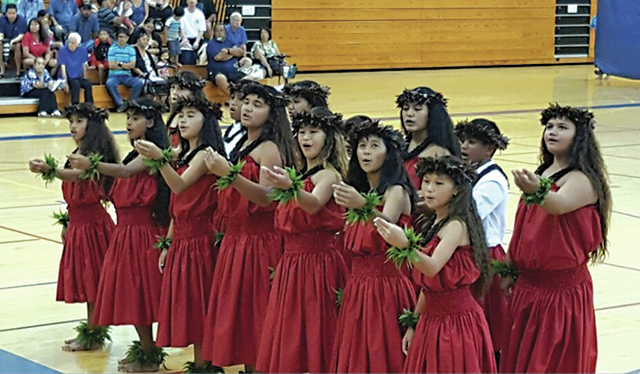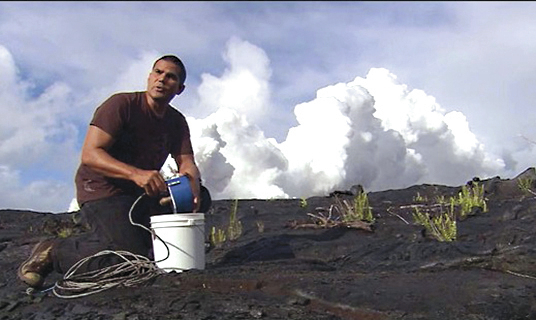Hawaii Volcanoes National Park continues its tradition of sharing Hawaiian culture and After Dark in the Park programs with the public throughout 2017.
Hawaii Volcanoes National Park continues its tradition of sharing Hawaiian culture and After Dark in the Park programs with the public throughout 2017.
January is Volcano Awareness Month and all After Dark programs will be presented by the USGS Hawaiian Volcano Observatory. After Dark and Hawaiian cultural programs are free, but park entrance fees apply.
Programs are co-sponsored by Friends of Hawaii Volcanoes National Park and Hawaii Pacific Parks Association.
Mark the calendar for these upcoming events:
34 Years and Counting: Updates on Kilauea Volcano’s Eruptions
As of Jan. 3, 2017, Kilauea has been erupting nearly continuously for the past 34 years. It began on the volcano’s East Rift Zone, where Pu‘u ‘O‘o continues to send lava flows down the flanks of Kilauea. In 2008, a second vent opened within Halema‘uma‘u Crater at the summit of Kilauea, where a spattering lava lake still lights the night sky and captivates spectators.
Tina Neal, scientist-in-charge of the USGS Hawaiian Volcano Observatory, briefly describes the history of these two eruptions and provides in-depth accounts of volcanic activity during the past year, including lava reaching the sea for the first time since 2013 and the rise and fall of the summit lava lake. Part of Hawaii Volcanoes’ ongoing After Dark in the Park series. Free.
When: 7 p.m. Jan. 3
Where: Kilauea Visitor Center Auditorium
The Unheard Sounds of Hawaiian Volcanoes
Infrasound is atmospheric sound and vibration below the threshold of human hearing. These low-frequency sounds are generated by large-scale fluid flow and can propagate for thousands of kilometers to provide early warning of natural or man-made hazards. Active open-vent volcanoes, such as Kilauea, are exceptionally good sound emitters and scientists are steadily building a continuous baseline of volcano-acoustic activity, including infrasonic tremor from Halemaʻumaʻu and Pu‘u ‘O‘o.
Join Milton Garces, director of the University of Hawaii Infrasound Laboratory, as he talks about “listening” to Kilauea, Mauna Loa and Hualalai volcanoes through one of the most advanced infrasound networks in the world. Part of Hawaii Volcanoes’ ongoing After Dark in the Park series. Free.
When: 7 p.m. Jan. 10
Where: Kilauea Visitor Center Auditorium
Ukulele-Making Demonstration
Join Oral Abihai as he shares his passion for making ukulele from local and exotic woods. A Native Hawaiian, Abihai has created ukulele for 10 years after his apprenticeship in Lahaina, Maui, with master builder Kenny Potts. Abihai loves to create ukulele in his spare time with bits and pieces of his wood collection. Part of Hawaii Volcanoes’ ‘Ike Hana No‘eau (Experience the Skillful Work) workshops. Free.
When: 10 a.m.-noon Jan. 11
Where: Kilauea Visitor Center lanai
Trials and Tribulations of Halemaʻumaʻu Crater: 200 Years Old and Still Going
Halema‘uma‘u, the large crater within Kilauea Volcano’s summit caldera, has a checkered past and an uncertain future. Probably first appearing in the early 19th century, Halemaʻumaʻu has enthralled visitors with its lava lakes, enticed at least three people to their deaths in past decades and served as a centerpiece for numerous photographs and paintings. Don Swanson, a USGS geologist at the Hawaiian Volcano Observatory, traces the volcanic history of Halemaʻumaʻu and includes personal anecdotes about his encounters with the crater during the 1967-68 eruption. Part of Hawaii Volcanoes’ ongoing After Dark in the Park series. Free.
When: 7 p.m. Jan. 17
Where: Kilauea Visitor Center Auditorium
Hula Performance by Halau I Ka Leo Ola O Na Mamo
Be immersed in authentic Hawaiian hula presented by kumu hula Pelehonuamea and kumu hula Kekoa Harman. Halau I Ka Leo Ola O Na Mamo is composed of the students of the Hawaiian language immersion school, Nawahiokalani‘opu‘u. These students are all fluent speakers of the Hawaiian language, which is being revived after many years of decline. Part of Hawaii Volcanoes’ ongoing Na Leo Manu (Heavenly Voices) presentations. Free.
When: 6:30-8 p.m. Jan. 18
Where: Kilauea Visitor Center Auditorium
How Do HVO Geologists Track Lava Flows and Lava Lakes?
Kilauea is home to two remarkably long eruptions. Pu‘u ‘O‘o and other vents on the volcano’s East Rift Zone have erupted lava flows for more than three decades. At the summit of Kilauea, an active vent within Halema‘uma‘u Crater has fed a lava lake for more than eight years. Monitoring each of these eruptions presents unique challenges and requires using various tools and techniques, ranging from low tech to state of the art. USGS Hawaiian Volcano Observatory geologist Matt Patrick explains the toolkit he uses to map lava flows and measure lava lakes and describes how scientists continuously improve their methods of tracking volcanic activity. Part of Hawaii Volcanoes’ ongoing After Dark in the Park series. Free.
When: 7 p.m. Jan. 24
Where: Kilauea Visitor Center Auditorium
Ho‘okani Ukulele (Learn to Play Ukulele)
Learn the basics of the beloved Hawaiian ukulele. The modern ukulele evolved from the machete de braga, a small stringed instrument introduced by Portuguese immigrants in the 1800s. The ukulele is now an iconic part of Hawaiian music culture. Part of Hawaii Volcanoes’ ‘Ike Hana No‘eau (Experience the Skillful Work) workshops. Free.
When: 10 a.m.-noon Jan. 25
Where: Kilauea Visitor Center lanai
An Update on Mauna Loa Activity and Monitoring Efforts
Mauna Loa, the largest active volcano on Earth, has erupted 33 times since 1843, most recently in 1984, when lava flows approached Hilo. Future eruptions could produce high-volume, fast-moving flows that reach the ocean in a matter of hours. In 2015, the Volcano Alert Level of Mauna Loa was elevated from “normal” to “advisory” because of increased seismicity and deformation at the volcano, which continue to occur.
USGS Hawaiian Volcano Observatory scientist Ingrid Johanson provides a brief account of Mauna Loa’s eruptive history, an update on its current status and an overview of how HVO scientists track activity that might presage the volcano’s next eruption. Part of Hawaii Volcanoes’ ongoing After Dark in the Park series. Free.
When: 7 p.m. Jan. 31
Where: Kilauea Visitor Center Auditorium





